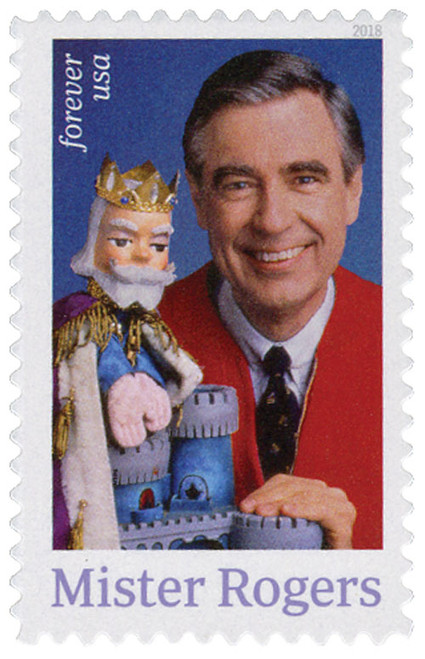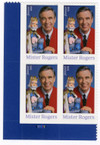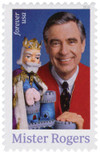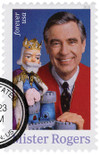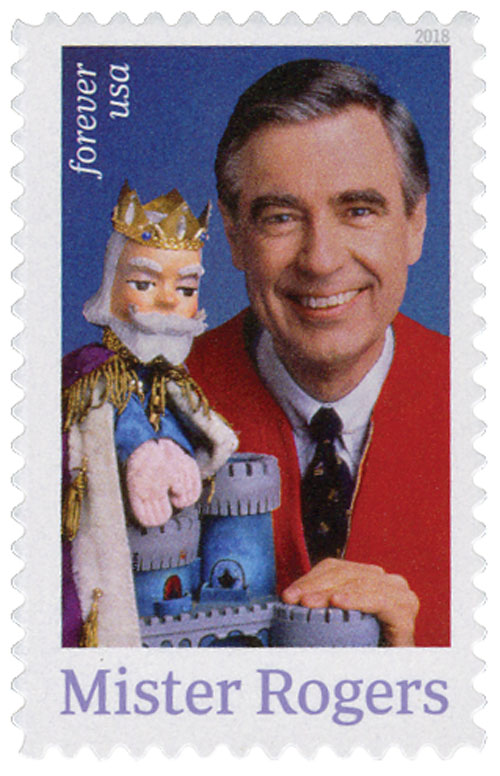
# 5275 - 2018 First-Class Forever Stamp - Mister Rogers
#5275
2018 50c Mr. Rogers
Value: 50¢ 1-ounce first-class letter rate- Forever
Issued: March 23, 2018
First Day City: Pittsburgh, PA
Type of Stamp: Commemorative
Printed by: Banknote Corporation of America
Method: Offset
Format: Pane of 20
Self-Adhesive
Quantity Printed: 12,000,000 stamps
Happy Birthday, Mr. Rogers
Rogers was a shy, introverted child, who often spent time at home alone playing with puppets. He also suffered from asthma, which also kept him at home. Rogers would spend his time creating his own world with his toys.
In high school, Rogers began to make friends and soon became president of the student council, a member of the National Honor Society, and editor-in-chief of the school yearbook. Rogers went on to earn a degree in music composition in 1951. Originally, Rogers wanted to go to seminary school after graduating, but after seeing a television at his parents’ house, he chose to find a job in that field. He later recalled, “I went into television because I hated it so, and I thought there’s some way of using this fabulous instrument to nurture those who would watch and listen.”
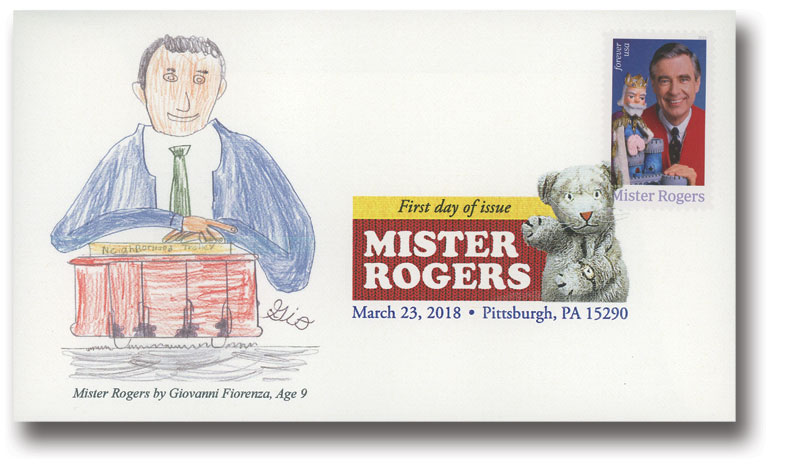
Rogers then went to work for NBC in New York City, working on Your Hit Parade, The Kate Smith Hour, and The Voice of Firestone. After two years in New York, Rogers returned to Pennsylvania and helped develop The Children’s Corner. The show would go on to earn a Sylvania Award and was broadcast nationwide on NBC. While working on the show, Rogers went to seminary school, graduating in 1963. During this time he also attended the University of Pittsburgh’s Graduate School of Child Development.
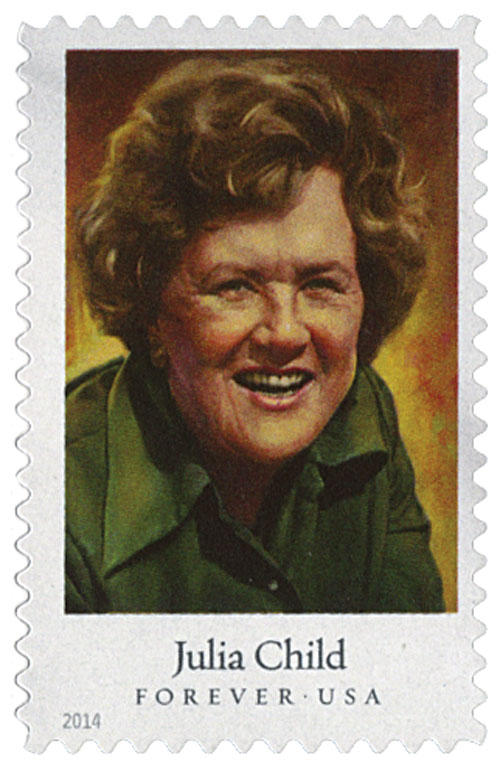
Also in 1963, Rogers was hired by CBC in Toronto to host a 15-minute children’s program called Misterogers. The head of CBC’s children programming insisted that Rogers be on television after seeing how he spoke with children. This show was Rogers’ first time appearance.
In 1967, Rogers got the rights to Misterogers and moved the sets to Pittsburgh, where he used them for his new show, Mister Rogers’ Neighborhood. The show first debuted on February 19, 1968. The show started a new trend in children’s TV. Rogers spoke directly to the audience in a “conversation” throughout the episode. Rogers also taught lessons about growing up, and tackling life’s obstacles, big and small. More importantly, he promoted kindness, respect, honesty, and being true to yourself. The show ran for 33 years, with a total of 895 episodes. During that time it won four Emmy Awards and Rogers received a Lifetime Achievement Award from the Daytime Emmy Awards.
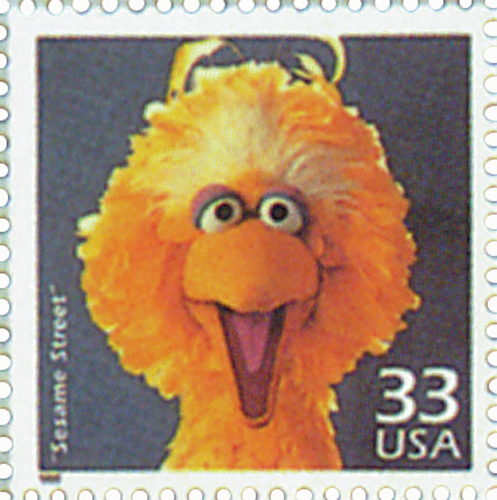
Rogers was always himself on camera – he believed kids could “spot a phony a mile away.” He also wrote over 289 songs for the show, each with a meaningful lesson. Much of the show was rooted in Rogers’ Christian values, though he never mentioned his religion on the show, so no one would feel excluded from his neighborhood.
In 1969, Rogers delivered a memorable six-minute testimony before the US Senate Subcommittee on Communications. Rogers spoke out about the need for children to have alternative television programs with positive messages. His speech moved the chairman of the committee, who commended Rogers and told him he had earned the $20 million in increased funding for PBS.
Rogers received a number of awards and honors during his life, including the Presidential Medal of Freedom, 40 honorary degrees, and induction into the Television Hall of Fame. After suffering from stomach cancer, Rogers died on February 27, 2003.
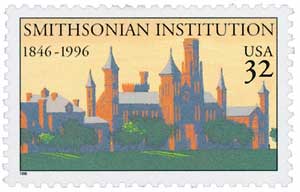
Click here for more from the official Mister Rogers’ Neighborhood website.
#5275
2018 50c Mr. Rogers
Value: 50¢ 1-ounce first-class letter rate- Forever
Issued: March 23, 2018
First Day City: Pittsburgh, PA
Type of Stamp: Commemorative
Printed by: Banknote Corporation of America
Method: Offset
Format: Pane of 20
Self-Adhesive
Quantity Printed: 12,000,000 stamps
Happy Birthday, Mr. Rogers
Rogers was a shy, introverted child, who often spent time at home alone playing with puppets. He also suffered from asthma, which also kept him at home. Rogers would spend his time creating his own world with his toys.
In high school, Rogers began to make friends and soon became president of the student council, a member of the National Honor Society, and editor-in-chief of the school yearbook. Rogers went on to earn a degree in music composition in 1951. Originally, Rogers wanted to go to seminary school after graduating, but after seeing a television at his parents’ house, he chose to find a job in that field. He later recalled, “I went into television because I hated it so, and I thought there’s some way of using this fabulous instrument to nurture those who would watch and listen.”

Rogers then went to work for NBC in New York City, working on Your Hit Parade, The Kate Smith Hour, and The Voice of Firestone. After two years in New York, Rogers returned to Pennsylvania and helped develop The Children’s Corner. The show would go on to earn a Sylvania Award and was broadcast nationwide on NBC. While working on the show, Rogers went to seminary school, graduating in 1963. During this time he also attended the University of Pittsburgh’s Graduate School of Child Development.

Also in 1963, Rogers was hired by CBC in Toronto to host a 15-minute children’s program called Misterogers. The head of CBC’s children programming insisted that Rogers be on television after seeing how he spoke with children. This show was Rogers’ first time appearance.
In 1967, Rogers got the rights to Misterogers and moved the sets to Pittsburgh, where he used them for his new show, Mister Rogers’ Neighborhood. The show first debuted on February 19, 1968. The show started a new trend in children’s TV. Rogers spoke directly to the audience in a “conversation” throughout the episode. Rogers also taught lessons about growing up, and tackling life’s obstacles, big and small. More importantly, he promoted kindness, respect, honesty, and being true to yourself. The show ran for 33 years, with a total of 895 episodes. During that time it won four Emmy Awards and Rogers received a Lifetime Achievement Award from the Daytime Emmy Awards.

Rogers was always himself on camera – he believed kids could “spot a phony a mile away.” He also wrote over 289 songs for the show, each with a meaningful lesson. Much of the show was rooted in Rogers’ Christian values, though he never mentioned his religion on the show, so no one would feel excluded from his neighborhood.
In 1969, Rogers delivered a memorable six-minute testimony before the US Senate Subcommittee on Communications. Rogers spoke out about the need for children to have alternative television programs with positive messages. His speech moved the chairman of the committee, who commended Rogers and told him he had earned the $20 million in increased funding for PBS.
Rogers received a number of awards and honors during his life, including the Presidential Medal of Freedom, 40 honorary degrees, and induction into the Television Hall of Fame. After suffering from stomach cancer, Rogers died on February 27, 2003.

Click here for more from the official Mister Rogers’ Neighborhood website.

